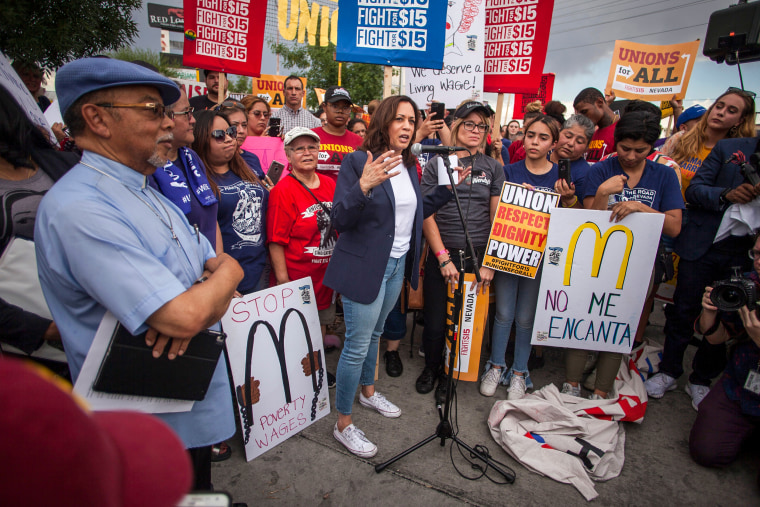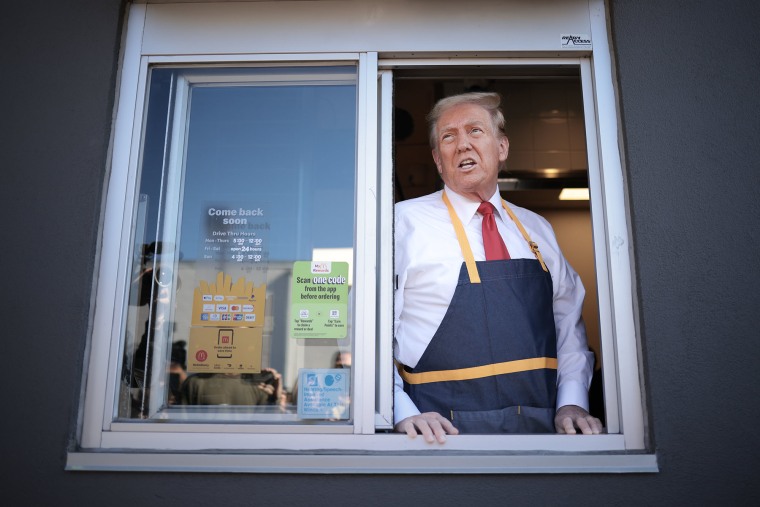Donald Trump’s campaign event Sunday at a McDonald’s in Pennsylvania highlighted his battle with Kamala Harris to court a coveted group of working-class voters who have the potential to decide the outcome of the presidential election in a critical swing state.
To win them over, the former president is seeking to make the election a referendum on the Biden-Harris administration’s record, while the vice president hopes to make it a choice between two contrasting agendas. Harris is pushing an expansion of the child tax credit, a subsidy for first-time homebuyers, a higher minimum wage and guaranteed paid leave, while the former president is calling for extending his tax cuts and slashing regulations in order to lower energy bills.
Data shows lower-wage workers — like ones who work at fast-food restaurants — have a lower propensity to vote. In fact, it’s a nearly linear relationship: The less money you make, the less likely you are to have shown up at the polls, according to Tufts University. Both candidates are trying to persuade and juice those voters in the final weeks before the election, and the image of Trump serving fries to supporters at a McDonald’s drive-thru was an attempt by the wealthy real estate mogul to reach out to the voters who will make or break his ambitions to return to the White House.
According to McDonald’s, approximately 1 in 8 Americans has worked at the fast-food chain at some point.
With the economy and cost of living consistently ranking as top issues, especially for persuadable voters, the two candidates’ economic agendas for wage earners could determine how these pivotal voters in battleground states cast their ballots.
Lower-wage workers would benefit more under plans put forward by Harris than those offered by Trump, according to an analysis of the policies the two candidates have provided by the University of Pennsylvania’s Wharton School.
“When you’re looking at direct policies, there’s no question that Harris is a little bit more skewed towards lower-income workers,” said Kent Smetters, a business professor who worked on the analysis.

The lowest-earning 20% of households could receive an average of $2,300 in various federal incentives under Harris’ plan, compared to around $350 under Trump’s plan, said Smetters. The incentives under Harris include an increase to the child tax credit, health care subsidies and assistance for first-time homebuyers.
But some of those gains by lower-wage workers under Harris would be offset by slightly slower wage growth as a result of a higher corporate tax rate that Harris is also proposing, compared with Trump, said Smetters. When factoring in that slower wage growth, lower-wage workers would see a benefit of around $1,750 more per year under Harris than Trump, he said.
Trump has offered more vague ways in which he would improve the overall economy, like cuts to regulations and lower corporate taxes that he has said would spur business investment. It is unclear though how those would translate into a benefit for lower-wage workers.
Trump has also proposed steep tariffs on imports, which he says would encourage companies to move manufacturing plants to the U.S., though economists have said that could drive up prices and trigger another wave of inflation. Trump has also said he would deport millions of immigrants, something that could increase demand for workers, and therefore wages, but also lead to worker shortages that would drive up prices.
The Wharton School analysis didn’t factor in the effect from both candidates’ proposals on exempting tips from federal taxes because implementing such a plan would require numerous additional regulations to prevent a large loss in tax revenue, Smetters said.
The clash comes in the midst of a national realignment. White voters without a college degree — who also tend to be lower income — have trended toward Republicans due to cultural divides, but Harris is using economic appeals to try and limit her margins of defeat in rural areas. Trump is also trying to peel off some Black and Latino working-class voters, a mainstay of the Democratic coalition, in a strategy that could shape the outcome of battleground states like Pennsylvania and Arizona if he’s successful.
A mid-October poll by The Associated Press measured which of the two candidates voters trust on a variety of economic issues. Harris won out by 10 points on handling “taxes on the middle class,” by 2 points on “jobs and unemployment” and by 5 points on “the cost of housing.” Voters trusted Trump by 2 points to handle “the cost of groceries and gas” and by 5 points on tariffs.
Both candidates have some ambiguities in their agenda. Harris’ campaign declined to say where she wants to set the federal minimum wage, which is currently $7.25 per hour. Her campaign also hasn’t said how many weeks of paid leave should be guaranteed, or how the cost of paying those workers in that time should be covered.
Meanwhile, Trump dodged multiple questions at the drive-thru about whether he supports raising the minimum wage. The president also hasn’t said if he favors guaranteeing paid leave.
Lower-wage workers have seen some of the biggest pay gains across the economy over the past four years, but also continue to face some of the biggest financial challenges when it comes to affording the rising cost of housing, food and utilities.
Front-line workers at fast-food restaurants earn an average of $16.26 an hour — an all-time high — and an 8% increase in wages when adjusted for inflation since President Joe Biden took office, according to the Bureau of Labor Statistics.
Under Trump, these workers’ hourly pay climbed 10.7% after adjusting for inflation.
The gap demonstrates the extent to which inflation during Biden and Harris’ term, though now slowing back to its long-term average, has impacted wage earners. Since February 2021, the consumer price index has soared 19.4%. During the Trump administration, it climbed just 7.6%.
In general, lower-wage workers across the economy have seen some of the largest pay gains since the start of the pandemic. When adjusted for inflation, wages for lower-income workers have jumped nearly 17% since 2019, according to data from the Economic Policy Institute. That compares to just a 7% increase for middle-wage workers when inflation is factored in.

The Harris campaign also highlighted her pro-union stances and tore into Trump’s proposal for aggressive tariffs, saying the taxes on imported goods will be passed along to the middle class in the form of higher prices.
“Donald Trump is running on a middle-class tax hike, Kamala Harris is running on a middle-class tax cut,” Harris campaign spokesperson James Singer said. “Donald Trump wants to repeal the Affordable Care Act, Kamala Harris will strengthen and expand the Affordable Care Act. And most importantly, as Donald Trump uses workers as props as he screws them over and sells them out, Kamala Harris has an agenda to help them and their families achieve the American dream.”
Trump’s team defended the tariffs as a bid to take on China.
“Not only will President Trump restore the booming economic climate of his first term, but he will eliminate taxes on tips and overtime pay and stand up to Communist China’s efforts to hurt American workers,” Republican National Committee spokesperson Anna Kelly said in an email. “Working families like rank-and-file Teamsters overwhelmingly support President Trump because only he will Make America Wealthy, Strong, and Great Again.”